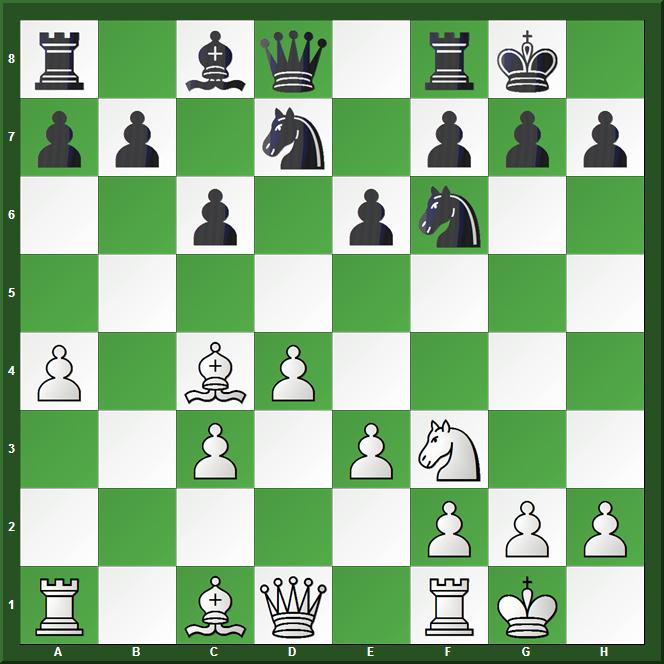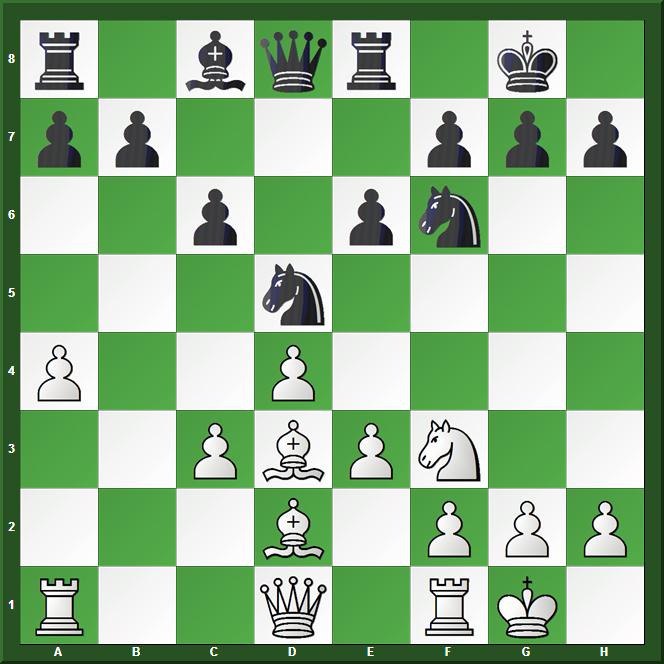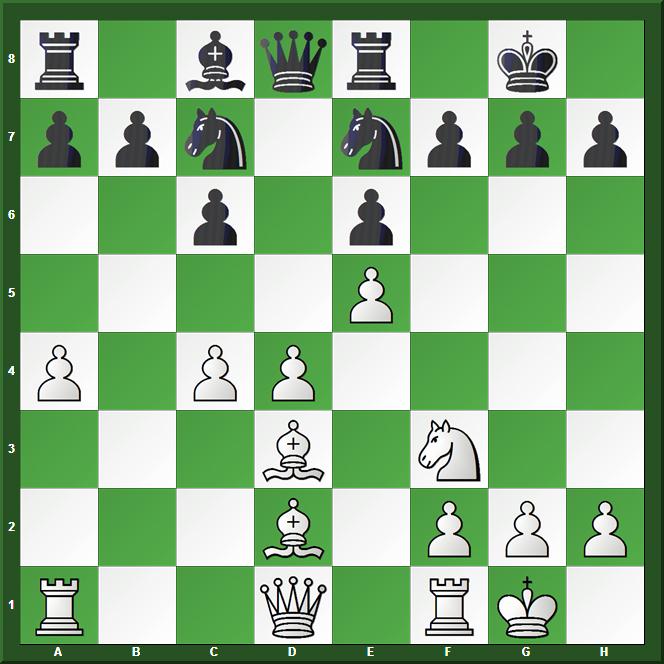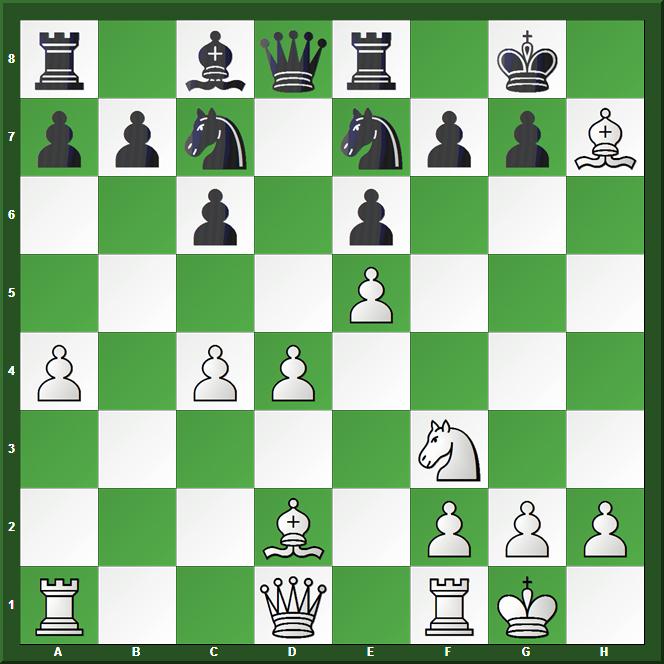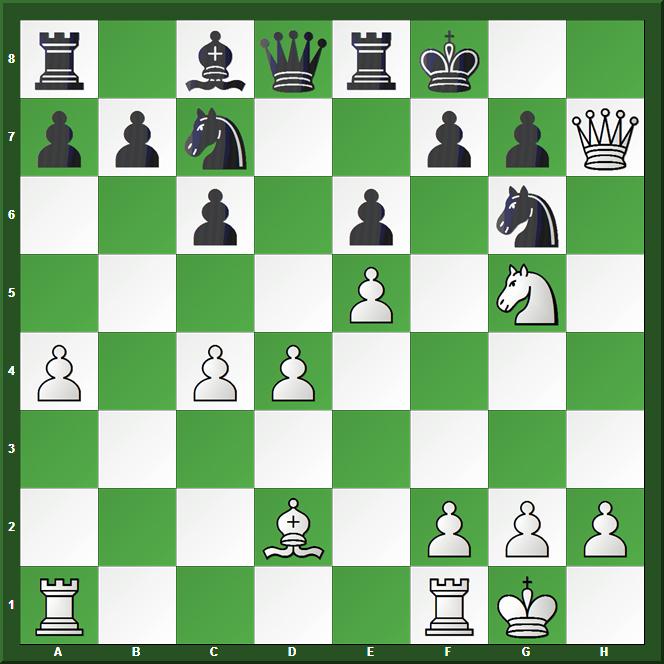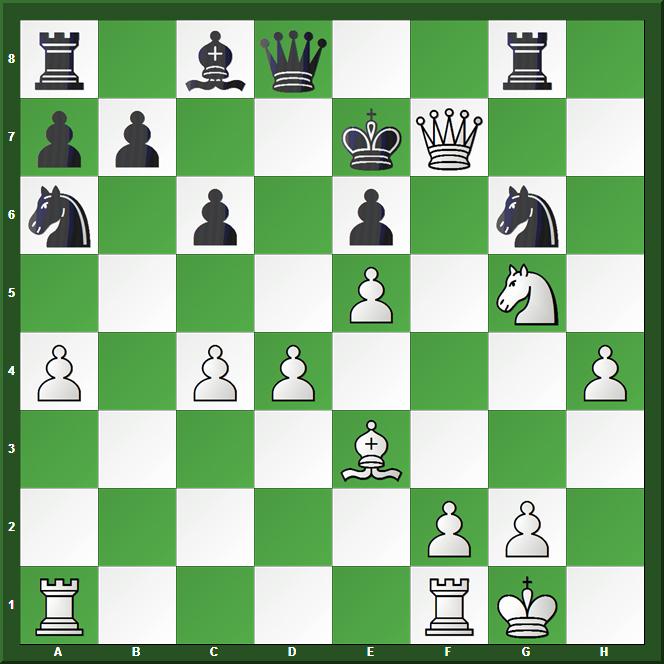All
the |
(Navigation bar
directly below.)
*******
© A.J. Goldsby, 2015.
(All rights reserved.)
****************
Click HERE
to see my
Chess Items.
****************
****************
Buy a book
from Amazon.com
(And help me out as well!)
****************
Click HERE
...
to see a list of the businesses that help to sponsor all of
my chess efforts.
|
|
|
This is a game that I played on-line on the Chess.com website. There were several people who were watching it. As soon as it was complete, one of the Internet spectators said that I should publish this game on one of my websites. It is a fairly good game, and many facets of it may be interesting to the average chess student. There are also a number of things that can be learned from this game, such as the use of a mobile Pawn center, and the Bishop sack on h7. ("Greek Gift.") The analysis is fairly detailed, and it should be quite useful, especially for lower-rated players. What is especially noteworthy is that I had the sack on h7 in mind ... starting from about my tenth move; how I was able to recognize the features that made this sacrifice possible and how I was able to set it up - well in advance - are the main reasons that I wanted to go ahead and share this game. (I hope that you enjoy it!) |
|
Click HERE to see an explanation of the symbols that I commonly use when I annotate any chess game. Click HERE to replay this game. Click HERE to see my video channel on the "You-Tube" channel. (Click HERE to see my YT video on this game.) FLchessplayer (1932) -
atty_at_win (1754)
|
|
|
[ Interesting was: 10.a5!? ]
Now a Pawn break ... (probably the advance of ...c6-c5) ... was called for.
10...Nb6?!;
('?') 11.Bd3 Nbd5; 12.Bd2 Re8;
(Probably '?!' here.)
This move was very likely an error, the box says it was better to try for (the plan of) ...Ne7-g6.
|
|
Now White tries to use his mobile Pawn center to gain a lot of space.
(Several engines now agree that White has a fairly large edge, and has a nearly won game.)
13.e4 Ne7;
14.e5 Nfd5; 15.c4 Nc7; (artificial)
This is probably (much) inferior to playing the Knight to b6/d7, and then possibly on to f8.
|
|
Now a crucial position has been reached, White must decide on which way to go from here.
16.Bxh7+!,
(Maybe - '!!') ---->
Destroys / rips away the Pawn cover in front of the BK.
This must be correct, if only from a philosophical standpoint, although some engines do actually prefer Ng5 at this point for White.
(I had this idea in mind, since right around move ten.).
|
|
With Black's pieces bunched on Q-side, a quick decision on the K-side is not only logical, it is the best way to end the game.
(This sacrifice is typical of the "GREEK
GIFT" ... usually a Bishop sack on h7.) - ye olde
editor
[ The continuation of: RR
16.Ng5 Nf5; 17.Qh5,
"-->"
yields White a very powerful (and a probably winning) attack ...
after only a handful of moves. ]
16...Kxh7;
17.Ng5+ Kg8[]; ("Box.")
This looked forced, the alternative of ...Kg6; appears to be much worse for Black. (See below.)
[ Worse was: </= 17...Kg6?; 18.Qg4 f5!?;
(Or, if Black plays: 18...Nf5 ; than simply 19.Nxe6+ , "+/-" wins for White. )
19.exf6 gxf6!?; 20.Ne4+! Kf7; 21.Qh5+ Kg7; 22.Bh6+ Kh8; 23.Nxf6, "+/-" ]
18.Qh5 Ng6[];
(Forced.)
Here, Black had no choice.
[ Worse was: </= 18...f6?;
19.exf6!,
Best.
(Or 19.Qf7+ Kh8; 20.Ra3, +-)
19...Nf5; (hmmm)
This is as good as anything else.
(Or 19...gxf6 ; 20.Qh7+ Kf8 ; 21.Qf7#.)
20.Qh7+ Kf8; 21.Qh8#. ]
19.Qh7+ Kf8;
Black has nearly run out of good (or useful) moves ...
|
|
20.Be3,
[ '!' or '?']
This is all wrong, yet this was the plan that I chose.
(This might even win for White, it MIGHT be possible to defend the second player's position ... in a tournament game.
However, in a game of 3-0, it is (IMO) not feasible that Black should be able to save his game ...
White's plan of h2-h4 is so strong that only a chess engine could find a decent defense.)
You might think I am very pleased with this game ... I am actually cross with myself for not finding a more energetic continuation,
something that would have been a substantial improvement over the course of the actual game ...
(See the two lines just below.)
[ White had two very brilliant winning lines here. They were:
#1.) >/= 20.Ra3!! Qxd4!?; 21.Nxf7!!, "+-"
Or #2.) >/= 20.Bb4+! Re7; 21.Ra3! Ke8; 22.Rf3! Qxd4; 23.Nxf7!, "+-" ]
20...Na6;
21.h4! Ke7; ('?')
This loses, although Black was probably much, much worse ... (and maybe even lost) in any event.
[ The best plan was probably >/= 21...b7-b6; yet nothing will save Black here, viz:
RR
21...b6; 22.h5 Nh4; 23.h6 Nf5;
24.hxg7+ Nxg7; 25.Ne4! Nf5; 26.Bg5,
"+/-"
(Black must give up the Queen, or allow a checkmate.) ]
At the end of the game, I had over 1.5 minutes left, while my opponent ran his time down to about 25 seconds ...
just after the sack on the h7-square. (Predictably, now very short of time, Black blunders.)
22.Qxg7 Rg8??; 23.Qxf7#.
|
|
The analysis of this game may prove useful to players below the level of (say) 1600 FIDE.
{Right after this was played, a lower-rated player requested that I analyze this game and then post it on my web-site.}
Copyright (c) A.J. Goldsby, 2012. All rights reserved.
1 - 0
Click HERE to see my web page on the "Greek Gift" sacrifice.
The analysis for this page was prepared with the excellent program, ChessBase 10.0. (I also used MANY chess engines!)
The HTML was polished with several different tools and programs, (mostly FP) ... the text was checked for spelling with MS Word.
|
Go ... or return ... to my Home Page for this site. Go (or return) ... to my "Annotated Games" (II) Page. Go
... or return ... to my "Best Games"
Page. *******
Copyright (c)
LM A.J. Goldsby
I ******* This
page was first generated in: September, 2012. Final
format / posting on: Wednesday; September 19th, 2012. |

